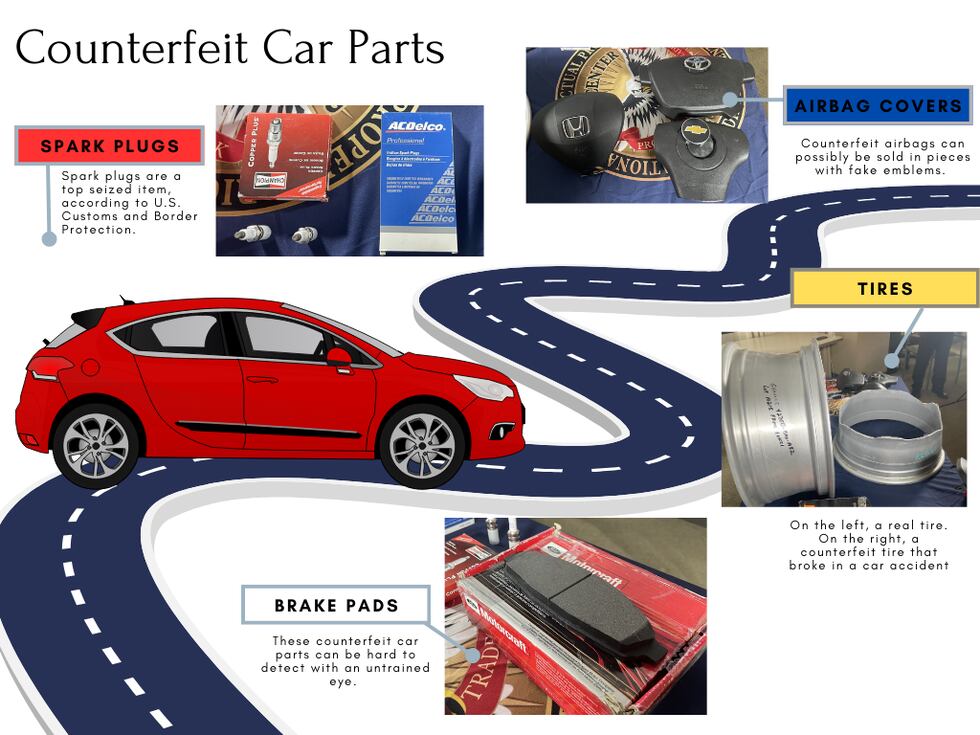‘Taking Advantage of That Trusted Brand’: Counterfeit auto parts pose serious risks to drivers
One federal agency trying to put the brakes on fakes has seized more than 839,000 counterfeit auto parts in the last five years
Arlington, VA (InvestigateTV) — As consumers keep their cars longer, the demand for affordable auto parts continues to rise. However, this growing trend has also created a dangerous problem: counterfeit car parts infiltrating the market.
These low-quality knockoffs, often indistinguishable from genuine parts, pose significant safety risks, leading to a rising number of serious accidents and fatalities.
Counterfeit auto parts, including oil filters, airbags, and spark plugs, are entering the U.S. through major ports and reaching consumers via online purchases from foreign countries. These parts are cleverly designed to mimic trusted brand-name products, complete with emblems and packaging, making it difficult for buyers to detect their fraudulent nature.
U.S. Customs and Border Protection (CBP) and Homeland Security Investigations (HSI) are working to combat the influx of counterfeit parts.
“The bad guys are taking advantage of that trusted brand to make money,” HSI Special Agent Andrew Lee said.
Lee, who is also a program manager at The National Intellectual Property Rights Coordination Center (IPR Center), explained these fake parts fail to meet the rigorous safety and durability standards set by the auto industry, often leading to malfunctions and endangering drivers during accidents.
Over the past five years, CBP has seized more than 839,000 counterfeit auto parts with a combined retail value exceeding $60 million. Among the seized items are brake pads, tires, keys, emblems, and grills.
Some of the most dangerous counterfeits involve airbags made from substandard materials.
“Airbag manufacturers don’t sell airbag parts separately, they will sell as entire components as a module,” Lee warned. Counterfeit airbags, often sold in pieces at drastically reduced prices, have been linked to serious incidents.
Faulty brake pads have also caused numerous crashes across the country.

The hidden dangers of counterfeit parts
While counterfeit auto parts may appear to be an affordable option, they come at a steep cost: safety.
According to vehicle safety experts, brake components, airbags, and suspension systems—all critical for vehicle safety—are among the most frequently counterfeited items. The number of counterfeit parts seized at U.S. ports nearly doubled between 2023 and 2024, officials said.
“You think you’re getting a really great deal on whatever that product is, and unbeknownst to you, it’s coming from a foreign manufacturer who has counterfeited that product. We try very hard to make sure it doesn’t reach you,” said Christopher Mabelitini, director for intellectual property and e-commerce at the CBP’s Office of Trade.
Mabelitini is on the front lines at the ports, including high-volume locations like Miami, Chicago, New York, and Los Angeles.
He noted that criminal organizations behind these counterfeits frequently use forged documents to by customs inspections, distributing these dangerous products to auto shops, repair centers, and dealerships. These operations often fund other illicit activities, further exacerbating the problem.
“They’re able to invest very little and make quite a bit,” he said.
A growing crisis with real-world consequences
The proliferation of counterfeit auto parts is a nationwide issue. Authorities estimate that millions of dollars worth of fake parts are imported annually. Investigations have uncovered sophisticated smuggling networks operating at major U.S. ports, sneaking counterfeit parts into legitimate supply chains.
In fiscal year 2024, CBP confiscated more than 89,000 counterfeit units of motor oil, the most seized fake product.
https://www.cbp.gov/newsroom/local-media-release/philadelphia-cbp-seizes-nearly-200k-counterfeit-auto-parts-china including fake airbag covers, fenders, bumpers, and trademarked logos for major auto manufacturers like Chevrolet, Buick, and Dodge.
In the past five years, HSI initiated 100 criminal cases involving counterfeit automotive parts. The agency is aware of at least three fatalities and two life-altering injuries between June 2023 and March 2024.
InvestigateTV found several lawsuits involving counterfeit parts, including one tragic case involving a 22-year-old mother of two in Florida. According to the lawsuit, the woman died when a counterfeit airbag unknowingly installed in her vehicle “denotated like a grenade and shot metal and plastic shrapnel throughout the vehicle cabin.”
To address this growing issue, the Automotive Anti-Counterfeiting Council (A2C2) was formed in 2015. Collaborating with North American automakers, A2C2 works to identify and stop counterfeit parts from reaching consumers.
The organization partners with law enforcement to investigate and prosecute offenders while educating the public about the risks of counterfeit products.
Tips for avoiding counterfeit parts
For over 40 years, D&S Steering Service, an auto-parts warehouse distributor, has been serving the New Orleans, Louisiana community.
D.P. Springer, the company’s vice president, said many consumers buy parts online and later visit his shop, unsure whether they’ve bought the right items or if they’ve fallen victim to counterfeits.
“In this business, a lot of things do come from overseas, that’s just the reality, but we have to make sure what’s coming over, it has to be, it’s going to be legitimate and, you know, someone ing something off for something it’s not,” Springer said.
To steer clear of counterfeit parts, experts suggested the following tips:
- Buy from trusted sources: Visit reputable mechanics or dealerships.
- authenticity: Consult with an original equipment manufacturer (OEM) or an aftermarket seller for guidance.
- Inspect parts carefully: Look for serial numbers, emblems, or markings that indicate authenticity.
- Be cautious online: Research the seller and the product’s country of origin. Avoid deals that seem too good to be true.
“Look at where the product is coming from, find out who the manufacturer is, and check the country of origin,” Mabelitini said. “A lot of online marketplaces and e-commerce sites provide more information—you may need to dig a little deeper.”
If consumers suspect a product is counterfeit, experts say they should report it to the National Intellectual Property Rights Coordination Center or the automakers’ brand protection department.
Copyright 2025 Gray Media Group, Inc. All rights reserved.















